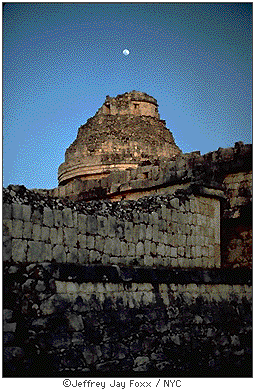Maya and Venus 
Image Source: http://www.astro.uva.nl/~michielb/maya/astro.html
The Mayans were gifted engineers and
mathematicians. They invented a complex system of writing and were
amazing astronomers. Their detailed studying of the celestial events
allowed them to create one of the more accurate calendars in existence
and gave them a profound understanding of the heavens. The Maya had
a particular interest in the planet Venus and its place in the sky.
They incorporated the planet into their politics, agriculture, and engineering.
The Maya regulated significant
political events such as attacks on other cities, sacrifices and other
ceremonies in conjunction with certain positions of Venus. “Hieroglyphic
inscriptions on Mayan monuments documented the role of Venus in power politics
in Mesoamerica (Krupp 97).” Glyphs documenting raids and defeats of rival
states were often paired with the glyphs for Venus and particular configurations
of Venus. “The Battle Mural at Bonampak, a Maya ceremonial center
in Chiapas, Mexico famous for its eighth century wall paintings, matches
the conflict to an inferior conjunction of Venus (Krupp 96).” Besides
warfare Venus had an influence in sacrifices to Mayan Gods related to their
agriculture.
Venus annually reaches its northernmost
point in the hemisphere just before the rainy season in Mesoamerica, making
it a symbol of fertility to the Mayans. Since Venus was associated
with rain and fertility it was paired with farming. The Mayans’ well being
depended on harvested grain and they attributed the quality of the harvest
to the appeasement of their gods. Thus sacrifices were offered to their
gods, and these ceremonies coincided with significant positions of Venus.
(Krupp 96) Although the mysticism of Venus revolved predominately
around agriculture and politics Mayans also incorporated it into engineering.
 Anthony F. Aveni discovered in the early nineteen-eighties a connection
between Caracol, a Mayan observatory at Chichen Itza and Venus. Apparently
the structure architecturally aligned with the northern limits of Venus
on the Horizon (Krupp 96). Many other such structures have similar
relations to celestial objects demonstrating just how much Venus and other
sky objects have affected Mayan culture.
Anthony F. Aveni discovered in the early nineteen-eighties a connection
between Caracol, a Mayan observatory at Chichen Itza and Venus. Apparently
the structure architecturally aligned with the northern limits of Venus
on the Horizon (Krupp 96). Many other such structures have similar
relations to celestial objects demonstrating just how much Venus and other
sky objects have affected Mayan culture.
The Mayan’s developed a vast
civilization and expanded by devoting many resources to furthering their
collective knowledge. Besides being great mathematicians, engineers,
and scholars, they were tremendous astronomers. “Their observatories
for star-gazing and their understanding of the mysteries of the planets
and stars were incredible. They could make astronomic calculations
well into the past and accurately predict eclipses of the sun and movement
of the moon. Their scholars perfected a solar calendar, more precise
than the contemporary Julian calendar, as accurate as any currently in
use (Salloum).” The Mayans incorporated astronomy throughout their
culture, documented by their abundant inclusion of Venus into their civilization.



 Anthony F. Aveni discovered in the early nineteen-eighties a connection
between Caracol, a Mayan observatory at Chichen Itza and Venus. Apparently
the structure architecturally aligned with the northern limits of Venus
on the Horizon (Krupp 96). Many other such structures have similar
relations to celestial objects demonstrating just how much Venus and other
sky objects have affected Mayan culture.
Anthony F. Aveni discovered in the early nineteen-eighties a connection
between Caracol, a Mayan observatory at Chichen Itza and Venus. Apparently
the structure architecturally aligned with the northern limits of Venus
on the Horizon (Krupp 96). Many other such structures have similar
relations to celestial objects demonstrating just how much Venus and other
sky objects have affected Mayan culture.